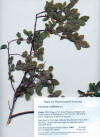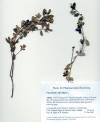| USDA records of procurement for cancer research
Vaccinium arboreum
Vaccinium deliciosum
Vaccium nivictum
Vaccinium parviflorum
Vaccinium scoparium
Vaccinium stamineum
Lala G., M.
Malik, C. Zhao, J. He, Y. Kwon, M. M. Giusti and B. A. Magnuson. 2006.
Anthocyanin-rich extracts inhibit multiple biomarkers of colon cancer in
rats. Nutr. Cancer 54(1): 84–93. “The aim of the
present study was to investigate the chemoprotective activity of
anthocyanin-rich extracts (AREs) from bilberry (Vaccinium myrtillus
L.), chokeberry (Aronia meloncarpa E.), and grape (Vitis
vinifera) by assessing multiple biomarkers of colon cancer in male
rats treated with a colon carcinogen, azoxymethane. Fischer 344 male rats
were fed the AIN-93 diet (control) or AIN-93 diet supplemented with AREs
for 14 wk. Biomarkers that were evaluated included the number and
multiplicity of colonic aberrant crypt foci (ACF), colonic cell
proliferation, urinary levels of oxidative DNA damage, and expression of
cyclooxygenase (COX) genes. To assess the bioavailability, levels of
anthocyanins in serum, urine, and feces were evaluated. Total ACF were
reduced (P<0.05) in bilberry, chokeberry, and grape diet groups compared
with the control group. The number of large ACF was also reduced (P<0.05)
in bilberry and chokeberry ARE-fed rats. Colonic cellular proliferation
was decreased in rats fed bilberry ARE and chokeberry ARE diets. Rats fed
bilberry and grape ARE diets had lower COX-2 mRNA expression of gene. High
levels of fecal anthocyanins and increased fecal mass and fecal moisture
occurred in ARE-fed rats. There was also a significant reduction (P<0.05)
in fecal bile acids in ARE-fed rats. The levels of urinary
8-hydroxyguanosine were similar among rats fed different diets. These
results support our previous in vitro studies suggesting a protective role
of AREs in colon carcinogenesis and indicate multiple mechanisms of action.”
Skupien K., J.
Oszmianski, D. Kostrzewa-Nowak and J. Tarasiuk. 2005. In vitro
antileukaemic activity of extracts from berry plant leaves against
sensitive and multidrug resistant HL60 cells. Cancer Lett. 236(2):
282–291. “The aim of the present study was to
determine in vitro antileukaemic activity of extracts obtained from
selected berry plant leaves (Fragaria x ananassa Duch. cv 'Elsanta',
raspberry Rubus ideus L. cv 'Polana' and blueberry Vaccinium
corymbosum L. cv 'Bluecrop') against promyelocytic HL60 cell line and
its multidrug resistant sublines exhibiting two different MDR phenotypes:
HL60/VINC (overexpressing P-glycoprotein) and HL60/DOX (overexpressing
MRP1 protein). It was found that the blueberry extract was the most
efficient against sensitive HL60 cell line (about 2-fold more active than
strawberry and raspberry extracts) but presented much lower activity
towards resistant cells. In contrast, strawberry and raspberry extracts
exhibited the high cytotoxic activity against sensitive leukaemia HL60
cell line as well as its MDR sublines. The values of resistance factor (RF)
found for these extracts were very low lying in the range 0.32/2.0.” |










